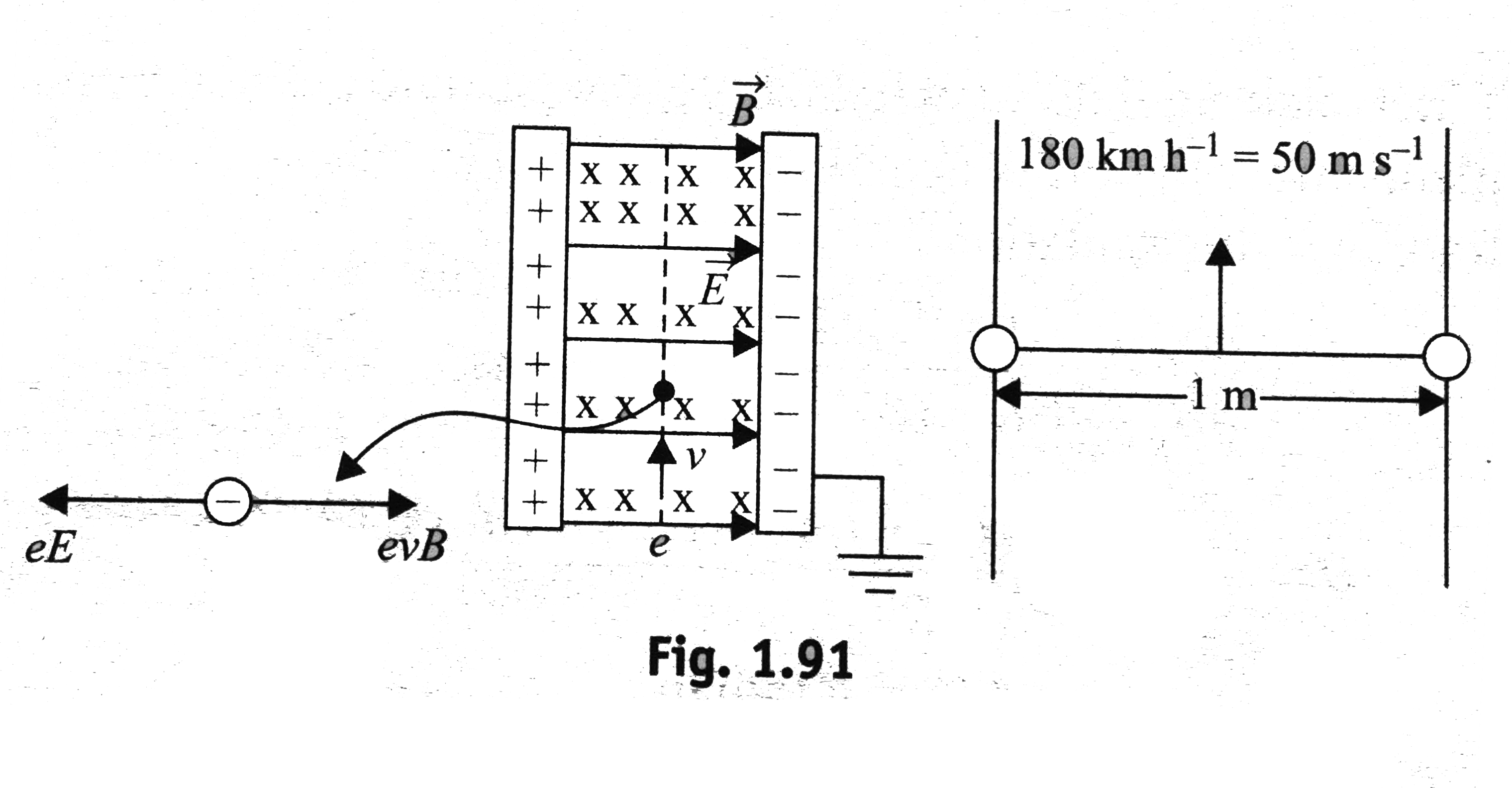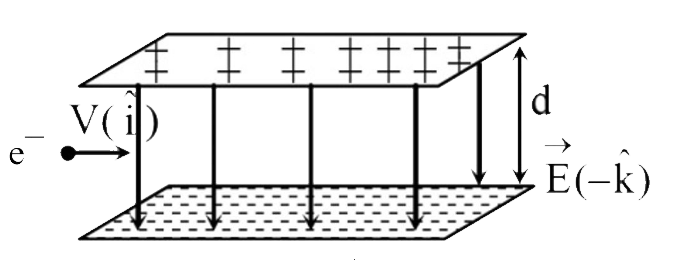A potential difference of 600vo<s is applied across the plates of a parallel plate consenser . The separation between the plates is 3mm. An electron projected vertically, parallel to the plates , with a velocity of 2×106m/sec moves underflected between the plates. Find the magnitude and direction of the magnetic field in the region between the condenser plates. ( Neglect the edge effects). ( Charge of the electron = -1.6xx10^(-19) coulomb)

The force on electron will be toward the left plane due to electric field and will be equal to Fe=eE.
For the electron to move undeflected between the plates, there should be a force (magnetic) which is equal to the electric force and opposite in direction to electric force. So the force should be directed toward the right as the electric force is toward the left. On applying Fleming's left hand rule, we get that the magnetic field should be directed perpendicular to the plane of paper and inwards. Therefore,
Force due to electric field=Force due to magnetic field
eE=evB[∵E=Vf]
B=Ev=V/dv

where V=potential difference between the plates, and
d=distance between the plates
B=600/3×10−32×106=6003×10−3×2×106⇒B=0.1T
Topper's Solved these Questions
- MAGNETIC FIELD AND MAGNETIC FORCESBOOK - CENGAGE PHYSICSCHAPTER - MAGNETIC FIELD AND MAGNETIC FORCESEXERCISE - Exercise 1.1
22 Videos
- MAGNETIC FIELD AND MAGNETIC FORCESBOOK - CENGAGE PHYSICSCHAPTER - MAGNETIC FIELD AND MAGNETIC FORCESEXERCISE - Exercise 1.2
13 Videos
- MAGNETIC FIELD AND MAGNETIC FORCESBOOK - CENGAGE PHYSICSCHAPTER - MAGNETIC FIELD AND MAGNETIC FORCESEXERCISE - Multiple Correct Answer type
2 Videos
- KINETIC THEORYBOOK - CENGAGE PHYSICSCHAPTER - KINETIC THEORYEXERCISE - Question Bank
31 Videos
- Magnetism and MatterBOOK - CENGAGE PHYSICSCHAPTER - Magnetism and MatterEXERCISE - Question Bank
50 Videos
Similar Questions
A potential difference of 600vo<s is applied across the plates of a parallel plate consenser . The separation between the plates is 3mm. An electron projected vertically, parallel to the plates , with a velocity of 2×106m/sec moves underflected between the plates. Find the magnitude and direction of the magnetic field in the region between the condenser plates. ( Neglect the edge effects). ( Charge of the electron = -1.6xx10^(-19) coulomb)

View SolutionWhat is the area of the plates of a 2 farad parallel plate air capacitor, given that the separation between the plates is 0.5 cm?
View Solution
Knowledge Check
To reduce the capacity of a parallel plate condenser, separation between the plates is
Areduced and area of the plates decreasedBdecreased and area of the plates increasedCincreased and area of the plates decreasedDincreased and area of the plates increasedWhat is the area of the plates of a 3 F parallel plate capacitor, if the sepreration between the plates is 5 mm ?
A1.694×109m2B4.529×109m2C9.281×109m2D12.981×109m2A potential difference of 500 V is applied across a paralle plate capacitor. The separation between the plates is 2×10−3m. The plates of the capacitor are vertical. An electron is projected vertically upwards between the plates with a velocity of 105m/a and it moves undeflected between the plates. The magnetic field acting perpendicular to the electric field has magnitude of
A0 Wb/m2B5/2 Wb/m2C10−6 Wb/m2D105 Wb/m2
A dielectric introduced between the plates of parallel plate condenser
View SolutionA dielectric introduced between the plates of parallel plate condenser
View SolutionA potential difference of 50 V is maintained between the two plates of a parallel plate condenser, separated by 5 mm of air. The energy stored in unit volume of air between the plates of the condenser is
View SolutionForce of attraction between the plates of a parallel plate capacitor is
View SolutionThe parallel plate capacitor has potential difference of 100 V and separation between the plate is 1 mm. An electron is projected along x axis in between the plates. If the electron comes out of the plates along the x axis undevated then the magnitude and direction of magnetic field that must be applied between the plates : (particle is projected with a velocity of 105m/s along x axis)

View Solution
